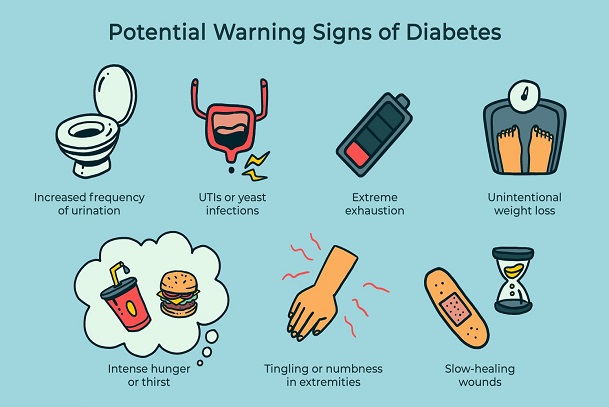 Wash your hands regularly and wear a face mask.
Learn more
Wash your hands regularly and wear a face mask.
Learn more

How Do You Know You Have Diabetes Mellitus (Clinical Features)?
One of the best ways to understand diabetes mellitus is by recognizing how this disease presents itself. Most diabetes patients do not recognize the signs or symptoms associated with diabetes mellitus thus not giving them ample time to begin treatment at its earliest hour.
It is important to recognize the early warning signs and symptoms of diabetes Mellitus because if this discovery becomes late, it becomes a life-threatening disease.
Clinical Features of Type 1 Diabetes Mellitus
Type 1 diabetes mellitus is a type of diabetes that occurs mostly in children and young adults where the body does not produce insulin. Symptoms of Type 1 diabetes typically start mild and get progressively worse or more intense, which could happen over several days, weeks, or months. This is because the pancreas makes less and less insulin.
Symptoms are:
Once these symptoms have presented themselves, it is essential that one visits a medical doctor and asked that the person be tested for Type 1 diabetes as soon as possible. The sooner one is diagnosed, the better.
If a diagnosis is delayed, untreated Type 1 diabetes can be life-threatening due to a complication called diabetes-related ketoacidosis (DKA). Emergency medical care is needed if a patient is experiencing any combination of the following symptoms which suggest diabetic-related ketoacidosis.
Illustrative Case
Master A.A is a 17-year-old Secondary School student who started having frequent urination with large volumes of urine, thirst, drinking water often, and appearing to lose weight even though he eats and drinks a lot of food and water. He was referred to see the school clinic.
Comments
These are symptoms that suggest the onset of childhood diabetes mellitus. He should be evaluated by a doctor to diagnose diabetes mellitus and treat it accordingly.
Clinical Features of Type 2 Diabetes Mellitus
Type 2 diabetes mellitus is the most common type of diabetes. Its symptoms often take several years to develop, making people not notice any symptoms at all. In type 2 diabetes, insulin is secreted by the patient but it is not effective because of the presence of insulin antagonists which impairs the function of insulin.
Type 2 diabetes usually occurs in adults, though more and more children and teens are developing it. Because symptoms are hard to spot and develop slowly, the symptoms may be mild and easy to dismiss at first. This is why it is important to know certain symptoms of type 2 diabetes that might present itself.
The symptoms may include:
These are common symptoms of type 2 diabetes mellitus.
Illustrative Case
B.O. is a 45-year-old civil servant who started noticing an increase in thirst and passing a lot of urine. He also noticed fatigue and increase food intake.
Comments
This patient is beginning to have symptoms suggestive of diabetes mellitus. He should see his doctor so that can be evaluated and his diabetes mellitus diagnosed and treatment started.